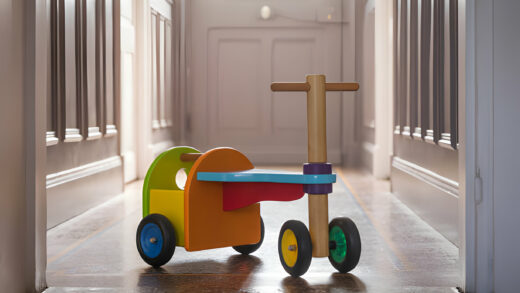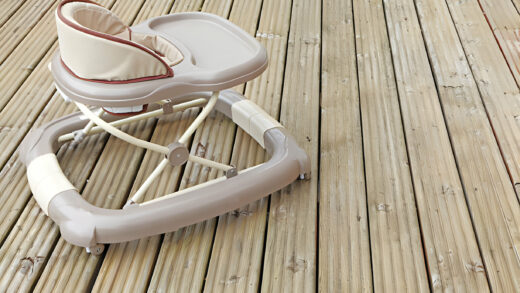You’ve probably seen it — the baby walker. Perhaps you even have one perched in your living room, a fast-moving piece of equipment that securely straps your child in and encourages those first steps. It’s an iconic symbol of baby’s first steps, but do you know how safe it is to use?
It’s understandable that parents might be worried. After all, a baby walker can move faster than a toddler can walk! Plus, with so many safety concerns about common products for babies, it is normal to be concerned about a baby walker.
The truth is that baby walkers can actually help prevent injuries because they provide support for your little one as he or she moves around. However, there are some guidelines you should follow when determining When Can a Baby Use a Walker. Let’s take a look at the basics so you can decide if the time is right for your little one.

When Can a Baby Use a Walker
When Can a Baby Use a Walker: Guidelines to Avoid Injuries
Baby Walkers: What Are They and How Do They Work?
A baby walker is a tool used to help babies learn how to walk while providing support and stability. It comes with an adjustable frame that fits over a baby’s hips and torso, as well as a base with a pair of swiveling wheels that help the baby move around and gain experience in standing up and walking.
These wheeled contraptions usually come in bright colors and are often equipped with fun features such as toys, music or electronic lights. A baby can use her legs to push off and propel the walker forward, engaging in activities she would not otherwise be able to do on her own at such an early age.
That being said, there are some potential safety risks associated with using a baby walker. Overuse can delay physical development of the lower extremities if it goes against recommended guidelines, leading to more serious developmental issues down the line. For this reason it is important for parents to know when their babies can safely start using a walker.
Age Guidelines for Using a Baby Walker
Knowing when your baby is ready to use a baby walker is important to keep them safe. According to the American Academy of Pediatrics (AAP), a baby should not be placed in a walker until they can sit up independently and pull themselves up to standing. Doing this allows them to put all their weight onto their feet which lessens the risk of injury.
In order for your child to safely use a baby walker, the AAP recommends the following guidelines:
- Your baby should be at least 5 months old before you can place them in a walker
- At the minimum, your child should have good head and neck control before using a walker
- The child’s legs should be strong enough to support their weight while pushing the walker
- Be sure that any toys and objects around the house are secured—keep any tablecloths and cords out of reach
- You must always supervise your child while they’re in the walker for safety purposes
Following these guidelines will help ensure that your little one reaps all of the developmental benefits of using a baby walker without endangering them.
Signs Your Baby Is Ready for a Walker
It’s important to know when your little one is ready for a walker. Here are a few things to look out for that may be signs that your baby is ready:
- Your baby is able to support their own weight and stand upright with assistance.
- Your baby is able to take steps or move around when they are held in a standing position.
- Your baby has good head control and can sit up on their own with minimal support.
If you notice these signs, your baby may be ready for a child walker. Before you begin using it, make sure the walker fits properly and securely – the height should reach just below your baby’s armpits and the padding must be comfortable against their chest. You should also choose a lightweight model so that it is easier to move around and push when needed.
Safety Precautions When Using a Baby Walker
When it comes to safety precautions, there are certain guidelines that should be followed in order to make sure your baby is safe while using a walker. Here are some important safety tips to consider:
Age Requirements
It’s important to make sure your baby is the right age to use their walker. Walkers are intended for babies who can sit upright and balance themselves without assistance. This usually happens around the 8-10 month mark. To be extra sure, it’s best to wait until the baby is over 12 months old before introducing a walker into their playtime.
Closely Supervise
No matter what age your baby is when they start using a walker, it’s important that you are around at all times supervising them. It only takes one second for something to go wrong, so keeping your eyes on them as they use the walker is essential.
No Stairs
Walkers should never be used near or on stairs, as this increases the risk of very serious injuries or death. Keep a close eye on where they’re going and don’t let them wander into an area that has stairs or steep ramps—no matter how curious they may seem!
Size Matters
The size of your baby’s walker matters too. Make sure you’re buying one that’s the right size for your baby so they don’t outgrow it quickly and find themselves in an oversized (and dangerous) contraption!
Choosing the Right Baby Walker Based on Your Baby’s Needs
When it comes to choosing the right baby walker, it’s important to consider your baby’s needs. Every baby has different milestones and abilities; some make progress faster than others. You know your baby best, so here are some things to consider when selecting the right walker:
Age
Experts recommend purchasing a walker that’s age-appropriate. According to the American Academy of Pediatrics (AAP), babies can start using a walker between 4-6 months of age or when they can support their own weight. Some babies may not be ready until after 6 months, but you know your own little one best.
Height and Weight Limit
Look for a walker with adjustable height settings, as well as an adjustable weight limit. After all, each child is unique in size and shape, and each one will outgrow their walker at different rates. A good rule of thumb is to make sure the seat is positioned at the hips of your baby for maximum security and comfort.
Safety Features
Finally, safety should be paramount when choosing any kind of baby gear—especially for walkers! Look for models with brakes, motion sensors, or even reversible seats that allow your little one to interact with parents face-to-face as they move around. With these great features—and some additional precautions—your little one will be exploring safely in no time!
Alternatives to Baby Walkers for Early Walking Milestones
If you’re looking for an option to a baby walker, there are plenty of alternatives. First of all, you can get baby activity centers which provide an exciting and engaging environment for your baby where they can explore their surroundings safely on their own two feet. These activity centers typically have plenty of features, including colorful shapes, buttons that make fun sounds, and even some slides and ramps to encourage them to move around.
You can also opt for a stationary activity center that grows with your baby. It typically features a table or play area with adjustable heights so it’s suitable from 6 months to 3 years old or more, giving your baby a place to stand and pull themselves up safely until they are able to walk confidently on their own.
Another alternative is the push toy walker—a great option for exploring confidence as it allows them to develop the skills needed for walking while keeping them close to the ground so they don’t fall over when taking their first steps.
Finally, there’s the tried and true method: just hold your baby’s hands as they take their first steps. This way you can keep them balanced and focused while learning how to use their feet properly in order to walk securely without the need of any product.
Conclusion
When it comes to baby walkers, it’s important to understand the risks and follow the guidelines set out by the American Academy of Pediatrics. It’s an important step to ensure that your baby can enjoy the benefits of a walker, without sustaining any injuries.
Not all parents agree with the AAP’s guidelines regarding the use of walkers, but it’s important to remember that the risks of injury are real. When it comes to the safety of your baby, it’s important to err on the side of caution and try to minimize any potential risk.
Ultimately, it is up to the parent to decide when a baby can safely use a walker. But, it is important to always consider the safety of your precious little one and make sure you are aware of the risks associated with walkers and follow the appropriate guidelines.



